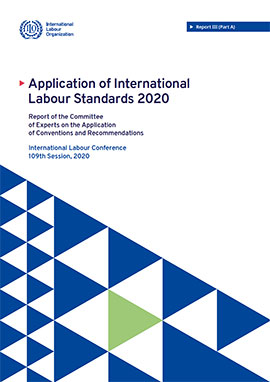In some cases, governments transmit the observations made by employers’ and workers’ organizations with their reports, sometimes adding their own comments. However, in the majority of cases, observations from employers’ and workers’ organizations are sent directly to the Office which, in accordance with the established practice, transmits them to the governments concerned for comments, so as to ensure respect for due process.
Observations from employers’ and workers’ organizations sent directly to the Office should clearly indicate the intention to submit observations to the CEACR and should be signed. They should reach the Office no later than 1 September each year. Organizations are encouraged to send their observations by email (ORGS-CEACR@ilo.org).
For reasons of transparency, the CEACR keeps record in its annual report of observations by employers’ and workers’ organizations. Appendix III to its report lists all observations received from them on the application of ratified Conventions. It is also possible to see the list of “Observations made by employers’ and workers’ organizations (Art. 23)” in each country, in the NORMLEX database with country profiles.
How the CEACR treats observations on ratified Conventions made by employers’ and workers’ organizations
The CEACR systematically recalls that the contribution by employers’ and workers’ organizations is essential for its evaluation of the application of Conventions in national law and in practice and, in the context of the regular review of its working methods, has adopted a practice for treating observations from both employers’ and workers’ organizations.
Where the CEACR finds that the observations are not within the scope of the Convention or do not contain information that would add value to its examination of the application of the Convention, it will not refer to them in its comments. Otherwise, the observations received from these organizations may be considered in a comment, taking the form of an observation or a direct request, as appropriate.
In a reporting year
When observations are not provided with the government’s report, they should be received by the Office by 1 September at the latest, so as to allow the government concerned to have a reasonable time to respond, thereby enabling the CEACR to examine the issues raised at its session the same year. When observations are received after, they would not be examined in substance in the absence of a reply from the government, except in exceptional cases, which are cases as those where the allegations are sufficiently substantiated and there is an urgent need to address the situation, whether because they refer to matters of life and death or to fundamental human rights or because any delay may cause irreparable harm. In addition, observations referring to legislative proposals or draft laws may also be examined by the CEACR in the absence of a reply from the government, where this may be of assistance for the country at the drafting stage.
Outside of a reporting year
When observations simply repeat those made in previous years, or refer to matters already raised by the CEACR, they will be examined in the year when the government’s report is due, in accordance with the regular reporting cycle. In this case, a report will not be requested from the government outside of that cycle. However, where the observations meet the above-mentioned criteria of exceptional cases, the CEACR will examine them in the year in which they are received, even in the absence of a reply from the government concerned.
Furthermore, where the observations on a technical Convention meet the criteria set out below, the CEACR will review the application outside of a reporting year. The criteria are:
- the seriousness of the problem and its adverse impact on the application of the Convention;
- the persistence of the problem; and
- the relevance and scope of the government’s response in its reports or the absence of response to the issues raised by the CEACR, including cases of clear and repeated refusal on the part of a State to comply with its obligations.
The CEACR will therefore request the Office to issue a notification to the government that the observations received on a technical Convention will be examined at its subsequent session with or without a response from the government. This would ensure that the government has sufficient notice while ensuring that the examination of matters of importance are not further delayed.


